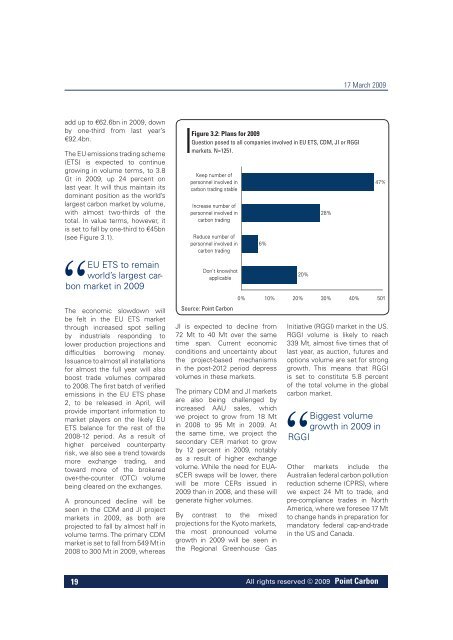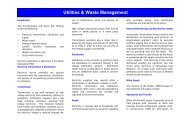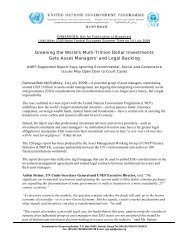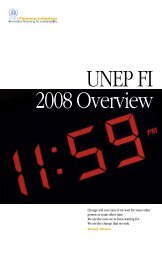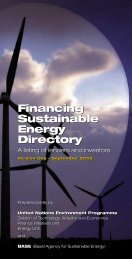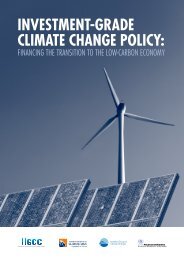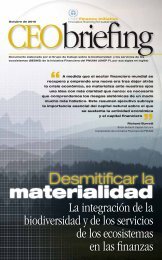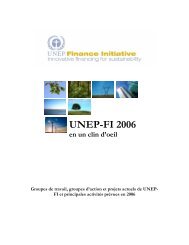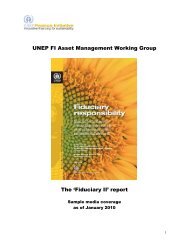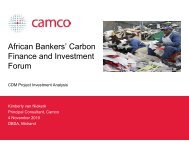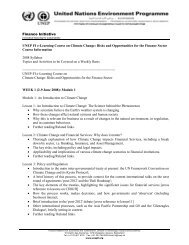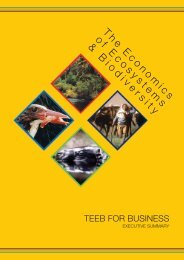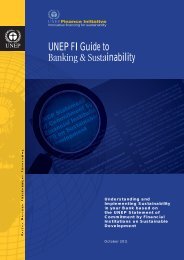Carbon 2009 Emission trading coming home - UNEP Finance Initiative
Carbon 2009 Emission trading coming home - UNEP Finance Initiative
Carbon 2009 Emission trading coming home - UNEP Finance Initiative
You also want an ePaper? Increase the reach of your titles
YUMPU automatically turns print PDFs into web optimized ePapers that Google loves.
17 March <strong>2009</strong><br />
add up to €62.6bn in <strong>2009</strong>, down<br />
by one-third from last year’s<br />
€92.4bn.<br />
The EU emissions <strong>trading</strong> scheme<br />
(ETS) is expected to continue<br />
growing in volume terms, to 3.8<br />
Gt in <strong>2009</strong>, up 24 percent on<br />
last year. It will thus maintain its<br />
dominant position as the world’s<br />
largest carbon market by volume,<br />
with almost two-thirds of the<br />
total. In value terms, however, it<br />
is set to fall by one-third to €45bn<br />
(see Figure 3.1).<br />
EU ETS to remain<br />
world’s largest carbon<br />
market in <strong>2009</strong><br />
The economic slowdown will<br />
be felt in the EU ETS market<br />
through increased spot selling<br />
by industrials responding to<br />
lower production projections and<br />
difficulties borrowing money.<br />
Issuance to almost all installations<br />
for almost the full year will also<br />
boost trade volumes compared<br />
to 2008. The first batch of verified<br />
emissions in the EU ETS phase<br />
2, to be released in April, will<br />
provide important information to<br />
market players on the likely EU<br />
ETS balance for the rest of the<br />
2008-12 period. As a result of<br />
higher perceived counterparty<br />
risk, we also see a trend towards<br />
more exchange <strong>trading</strong>, and<br />
toward more of the brokered<br />
over-the-counter (OTC) volume<br />
being cleared on the exchanges.<br />
A pronounced decline will be<br />
seen in the CDM and JI project<br />
markets in <strong>2009</strong>, as both are<br />
projected to fall by almost half in<br />
volume terms. The primary CDM<br />
market is set to fall from 549 Mt in<br />
2008 to 300 Mt in <strong>2009</strong>, whereas<br />
Figure 3.2: Plans for <strong>2009</strong><br />
Question posed to all companies involved in EU ETS, CDM, JI or RGGI<br />
markets. N=1251.<br />
Keep number of<br />
personnel involved in<br />
carbon <strong>trading</strong> stable<br />
Increase number of<br />
personnel involved in<br />
carbon <strong>trading</strong><br />
Reduce number of<br />
personnel involved in<br />
carbon <strong>trading</strong><br />
Don't know/not<br />
applicable<br />
Source: Point <strong>Carbon</strong><br />
6%<br />
JI is expected to decline from<br />
72 Mt to 40 Mt over the same<br />
time span. Current economic<br />
conditions and uncertainty about<br />
the project-based mechanisms<br />
in the post-2012 period depress<br />
volumes in these markets.<br />
The primary CDM and JI markets<br />
are also being challenged by<br />
increased AAU sales, which<br />
we project to grow from 18 Mt<br />
in 2008 to 95 Mt in <strong>2009</strong>. At<br />
the same time, we project the<br />
secondary CER market to grow<br />
by 12 percent in <strong>2009</strong>, notably<br />
as a result of higher exchange<br />
volume. While the need for EUAsCER<br />
swaps will be lower, there<br />
will be more CERs issued in<br />
<strong>2009</strong> than in 2008, and these will<br />
generate higher volumes.<br />
By contrast to the mixed<br />
projections for the Kyoto markets,<br />
the most pronounced volume<br />
growth in <strong>2009</strong> will be seen in<br />
the Regional Greenhouse Gas<br />
20%<br />
28%<br />
47%<br />
0% 10% 20% 30% 40% 50%<br />
<strong>Initiative</strong> (RGGI) market in the US.<br />
RGGI volume is likely to reach<br />
339 Mt, almost five times that of<br />
last year, as auction, futures and<br />
options volume are set for strong<br />
growth. This means that RGGI<br />
is set to constitute 5.8 percent<br />
of the total volume in the global<br />
carbon market.<br />
Biggest volume<br />
growth in <strong>2009</strong> in<br />
RGGI<br />
Other markets include the<br />
Australian federal carbon pollution<br />
reduction scheme (CPRS), where<br />
we expect 24 Mt to trade, and<br />
pre-compliance trades in North<br />
America, where we foresee 17 Mt<br />
to change hands in preparation for<br />
mandatory federal cap-and-trade<br />
in the US and Canada.<br />
19<br />
All rights reserved © <strong>2009</strong> Point <strong>Carbon</strong>


